Falconry. Centuries old sport of kings and the refined noble-elite of the middle ages. And it’s still some badass hunting today.
This is cool stuff. Some background first:
Background Part
Knights and lesser nobility trained for battle by thundering around on a horse with a lance. They went on to perfect group combat skills on organized hunts for deer and boar. These hunts kept a knight’s skills honed for war.
But the true nobility would never see actual combat and so their hunting was more refined and, on the cool side - way more primal (more on this later). Imagine – you’ve trained (sort of) this wild creature to hunt for you, yet every time you release it, you never really know if it will come back to you.
So, only the truly wealthy and most prestigious nobles could really even afford the sport. Falcons were a prized possession; like an exotic car is today. Would Justin Beiber chrome his falcon? Yea probably. He’s neat.
In the 1300’s it’s said King Edward III spent more on his falcons than all of his noble’s incomes….combined. King Eddie’s falcons were so prized; he even had their perches in his bed chamber.

Yea, so, whatever that’s about. We’re guessing King Edward had a few issues.
Trivia Lover’s Part
So fast forward to today and we have a whole ton of expressions based on Falconry. Trivia buffs will enjoy this part
Golf Caddie – The guy that followed his noble around the fields lugging the birds carried them on a cadge. Cadge evolved to caddie and guys are still lugging stuff around for the wealthy today.
Under Your Thumb – Holding a razor-taloned falcon is sketchy, even with thick gloves. You don’t want them moving around too much on your hand so the technique is to keep them still with your thumb on their talons. Then you’ve got the beast under your thumb.
For extra security that she won’t fly off, a little bird leash is wrapped around your little finger.
And for most of you who’ve had enough trivia by this point – fed up. Falcons are taken out to hunt quite hungry. But after they’ve eaten, their gullets swell up and they become sedate and listless and are quite simply fed up.
Cool Hunting Part
Today Falconry is just as elusive to us commoners as it’s always been. Without knowing individual falconers, it's hard to spend time with birds of prey.
Even then, most falconers have spent two years training their birds - maybe longer if they caught it wild - and are reluctant to let anybody else hold them, much less hunt them.
There are very few training centers, but it's pretty easy to find tourist centers around the UK and Europe that do "displays" where the birds fly up into a tree or you get to hold it on a glove. Which is cooler than going through another museum, but still.
Dalhousie Castle in Scotland (wiki link HERE)is setup like this. So most of the bird handlers there aren't really falconers, they're tour guides.
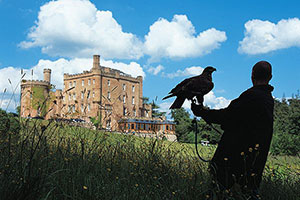
The upside is, a place like this has a wide variety of birds: four big owls of different kinds, five small birds of prey (tiny owls and a merlin), four Harris hawks, a buzzard (not the vultures we call buzzards in America, just a type of hawk), four peregrine falcons, a steppe eagle and a raven - twenty birds in all. Not shabby at all.
The first day, I spent a few hours with a trainee tour guide, flying the buzzard and Harris hawk, both members of the Accipitridae family of diurnal birds of prey.
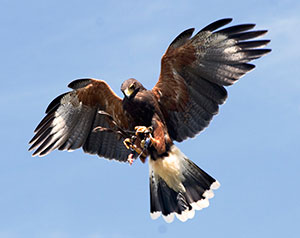
What's interesting is how differently they land on your glove. Using his tail feathers to brake, the buzzard touches down very lightly.
The Harris stays in horizontal flight longer, then goes upright, flings its claws forward from the hip and grabs onto your hand strongly. This brings us back to the primal part – they land how they hunt. The buzzard is a scavenger and the Harris is a predator...
Dumbass Shiloh
Owls have never interested me and I'm even less interested now that I know how stupid they are. The owner of Dalhousie Castle tells us they're about 15% as intelligent as a hawk.
Plus they’re friggin creepy. Especially those concave faces.
When they released Shiloh, a big horned owl, to show the tourists, it flew way up into a pine tree and didn't come down for hours. Stupid owl.
To mimic what happens in nature, they keep a bird hungry the night before a hunt. No bird will bother to hunt unless it's hungry - just like in the wild.
They confirm it's stomach is empty by weighing it. So stupid Shiloh was definitely hungry but just wouldn't come down.
They tried swinging a frozen squirrel on a lure then waving around a headless quail - its favorite. Nothing worked till they scattered (defrosted) day-old chicks at the base of the tree and held them down with their feet, so he wouldn't just snatch them up and leave again.
…they had me at headless quail.
Eagle
The petite trainee tour guide was clearly intimidated by the massive steppe eagle and I wrongly thought she was a wimp until I held the eagle myself the next day.
This one was 20 inches high, 8 lbs., with claws half the size of your hand that gripped so tightly it almost hurt.
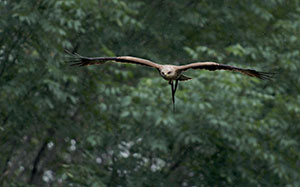
If it moved off the glove a bit, it would easily slice your arm to the bone. It had the hood on when I held it and I was nervous. But it might've been that particular bird. The day before it had destroyed the hood they put on it and fought the rope all day. It seemed very restless and unhappy.
Ferrets? Yes, Ferrets. And Frankie.
The second day, I got lucky. First, I woke to ten inches of beautiful snow. The stony, complicated architecture in Edinburgh looks incredible covered in snow.
In the morning, we hunted on the castle grounds with two albino ferrets and a couple of tourists. Who also passed on the headless quail and I did question the rationale of taking albino ferrets out to hunt in the snow…
Since the area was known to have very few rabbits (after a virus killed them off a few years ago) and since I thought I'd paid for private hunting, it was a bit disappointing, but still interesting to climb over fallen trees and hedges on the snowy hillsides, to watch the ferrets work, and to fly the Harris hawk and buzzard again.
The second bit of luck turned out to be Lizzette. She and her boyfriend Tom are falconers. Iona, one of the peregrines, was hers and she'd agreed to go out hunting in the moors with me in the afternoon with Tom, an avid falconer of fifteen years.
An additional background bit, courtesy of Lizzette: By the latter middle ages in England, almost everyone had a bird of prey. It's how they got meat.
The peasants weren't allowed to fly the posh birds reserved for the nobility – couldn’t afford them anyway - but even a lowly castle cook would get the pheasants, hares, partridges, rabbits, squirrels, etc., for dinner by hunting a bird of prey.
For the private afternoon hunt, we took two SUVs and drove out to a farm in Lothian then trudged for miles across plowed, snow-covered fields, climbing fences, cough..primal..cough, and stomping on the remnants of last season's crops, to get to a margin of trees and brambles.
Instead of ferrets, which are best for rabbit holes, we had an eager black 18-month-old puppy, Frankie, who leaped like a jack rabbit, over trees and four foot fences.
Tom had a goshawk he'd trained for two years, from birth. Lizzette clearly disliked the temperamental, antisocial goshawks. They're difficult to train and quick to hunt on their own if you fall behind. They don't like strangers and hate dogs. If they so much as see a dog, they might refuse to hunt.
Peregrines, like hers, are the fastest thing in the sky. They fly straight up and dive at 250 mph, breaking the neck of a rabbit in a blow.
Harris hawks, still my favorite, are the smartest hawk and by far the most successful predators of any species. But Harris's are tired after one full-out chase.

A goshawk can bring home 10-15 pheasants or rabbits in a day. Incredible endurance. Tom claims that, ultimately, they're faster to reach the prey because they don't have to go up into the sky. They fly directly toward their prey.
Hunting, like a good thriller, is mostly suspense - walking, climbing and looking for hiding animals - with about 30 seconds of thrill, when something's flushed and the hawk gives chase. Three times, Frenchie flushed pheasants or rabbits, and the goshawk flew after them.
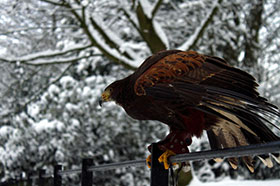
A pheasant happened to fly out into a clearing ahead of us, its long tail streaming behind it. In free flight, a pheasant is faster than a goshawk, so it has to either make a wrong turn, or bump into a fence or something for the goshawk to catch it. But the goshawk has far better endurance.
So if it can follow the pheasant, the goshawk can sit high above it and wait for the dog to come flush it out. The tired pheasant won't be able to fly quickly the second time, so the goshawk has a chance.
The brambles were so thick this time, the dog never found it and Tom's face was bleeding from climbing through the thorns.
Still, it's hard to describe the feeling of being out there doing something so fundamental to who we are and always have been.
Hunting with a gun is fine, but this is different. You get to participate in something that's happening around the world in 1,000s of places every day - and has been since the beginning. Primal.
We're so far removed from it now, buying our food vacuum packed in temperature-controlled stores, that getting to experience this primal struggle for survival is utterly awe-inspiring.
If you can find somebody at that training place to take you hawking, do it. It takes incredible dedication, so it's not something a tour guide could do. Falconers tend to be passionate about it. Tom and Lizzette brought that quality and it really made the difference.
Awesome photo credits to: Humberpike, Ian Parks, Adam Zdebel, FurLined, How-To-Hunt-Rabbit. Thanks gents!

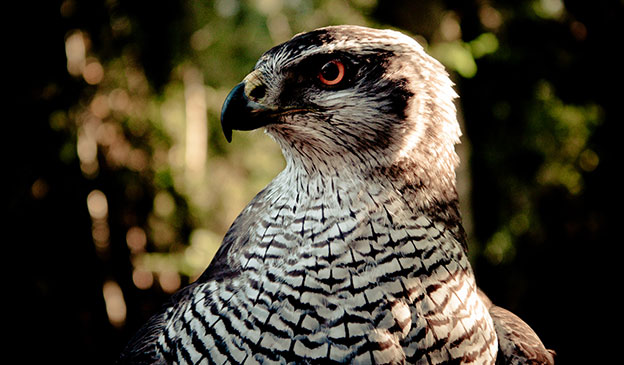
Leave a Reply
You must be logged in to post a comment.